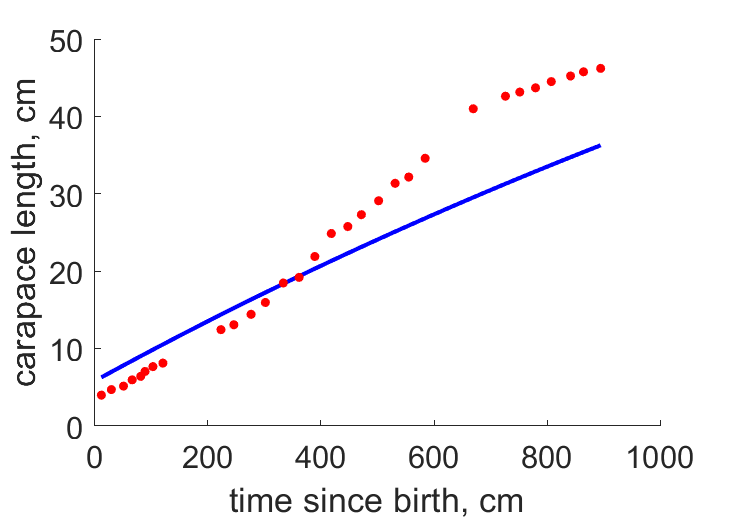Predictions & Data for this entry
| Model: std | climate: MA | migrate: Mo | phylum: |
| COMPLETE = 2.5 | ecozone: MC | food: biCi, biCis, biHl | class: |
| MRE = 0.182 | habitat: 0iMp | gender: Dtmf | order: |
| SMSE = 0.079 | embryo: Tnt | reprod: O | family: |
Zero-variate data
| Data | Observed | Predicted | (RE) | Unit | Description | Reference |
|---|---|---|---|---|---|---|
| ab | 60 | 48.04 | (0.1993) | d | age at birth | Wiki |
| tp | 7300 | 6989 | (0.0426) | d | time since birth at puberty | Wiki |
| am | 2.92e+04 | 2.926e+04 | (0.002022) | d | life span | guess |
| Lb | 4.2 | 5.806 | (0.3823) | cm | carapace length at birth | ADW |
| Lp | 83.8 | 104.9 | (0.2522) | cm | carapace length at puberty | Witz1980 |
| Li | 100 | 112.7 | (0.1273) | cm | ultimate carapace length for females | Wiki |
| Wwb | 16.5 | 17 | (0.0301) | g | wet weight at birth | ADW |
| Wwi | 1.27e+05 | 1.244e+05 | (0.02021) | g | ultimate wet weight for females | Wiki |
| Ri | 0.137 | 0.1372 | (0.001212) | #/d | maximum reprod rate | Wiki |
Uni- and bivariate data
| Data | Figure | Independent variable | Dependent variable | (RE) | Reference |
|---|---|---|---|---|---|
| LdL |  | curved carapace length | change in curved carapace length | (1.065) | BellPike1980 |
| tL |  | time since birth | carapace length | (0.2094) | Witz1980 |
Pseudo-data at Tref = 20°C
| Data | Generalised animal | Eretmochelys imbricata | Unit | Description |
|---|---|---|---|---|
| v | 0.02 | 0.04376 | cm/d | energy conductance |
| p_M | 18 | 59.45 | J/d.cm^3 | vol-spec som maint |
| k_J | 0.002 | 0.002335 | 1/d | maturity maint rate coefficient |
| k | 0.3 | 0.3078 | - | maintenance ratio |
| kap | 0.8 | 0.9181 | - | allocation fraction to soma |
| kap_G | 0.8 | 0.8012 | - | growth efficiency |
| kap_R | 0.95 | 0.95 | - | reproduction efficiency |
Discussion
- Males are assumed not to differ from females
- tL data of Witz1980 was ignored, due to inconsistency with other data
Facts
- The hawksbill is biofluorescent, possibly because of its coral food, like Physogyra lichtensteini. (Ref: Wiki)
Bibliography